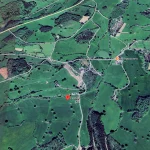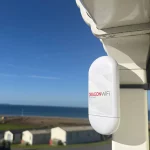Broadband from Hot Air Balloons – Loon Secures £97m Investment
After several years of development Alphabet’s (Google) Loon project, which hopes to distribute mobile broadband (4G / 5G) connectivity from High Altitude Platforms (stratospheric balloons), has just secured an investment of £97m ($125m) from SoftBank’s HAPSMobile in order to help support their commercial roll-out (due to begin this year).
The idea of using balloons to distribute mobile and broadband signals is nothing new, although most such deployments tend to take place at a very low altitude and are often only designed as short-term fixes for localised network outages or events coverage (e.g. mobile operator EE can deploy smaller blimps for just such a purpose).
By comparison Loon’s super-pressure, helium-filled and solar powered balloons are designed to drift (controlled) at about 20km (12 miles) above the Earth’s surface in the stratosphere. From there they can act a bit like a budget Satellite, albeit with significantly less coverage and so several balloons are often required to cover a wide area (e.g. during 2017 one test used 7 balloons to cover an area of 1,000km).
Advertisement
The balloons can stay aloft for months at a time (one test remained in the sky for nearly 200 days) and it’s possible to relay data, point-to-point, between two balloons at distances of up to 600km. The balloons then use patch antennas (directional antennas) to transmit their signals to ground stations or 4G (LTE) users. A user needs nothing more than a standard 4G phone to connect to a Loon balloon.
https://www.youtube.com/watch?v=BEC0G2HbuiE
The main focus of this effort is thus to improve connectivity to poorly served and less well developed parts of the world. As such the first commercial deployment is due to take place in Africa, around the regions of central Kenya, which forms part of a joint project with Telkom Kenya. All of this should now benefit from the new HAPSMobile investment.
Alastair Westgarth, Loon CEO, said:
“We see joining forces as an opportunity to develop an entire industry, one which holds the promise to bring connectivity to parts of the world no one thought possible. This is the beginning of a long-term relationship based on a shared vision for expanding connectivity to those who need it. We look forward to what the future holds.”
HAPSMobile, SoftBank’s subsidiary, is also a joint venture with AeroVironment that has just completed development of HAWK 30, its aircraft-type stratospheric telecommunications platform. Suffice to say that both sides hope to learn from each other in the development of their respective technologies.
Advertisement
The Collaboration Includes
* A wholesale business that would allow HAPSMobile to utilize Loon’s fully-functioning vehicle and technology. Likewise, Loon would be able to utilize HAPSMobile’s aircraft, which is currently in development, upon its completion.
* A jointly developed communications payload that is adaptable to multiple flight vehicles and various ITU compliant frequency bands.
* A common gateway or ground station that could be deployed globally and utilized by both Loon and HAPSMobile to provide connectivity over their respective platforms.
* Adapting and optimizing Loon’s fleet management system and temporospatial SDN for use by HAPSMobile.
* Creating an alliance to promote the use of high altitude communications solution with regulators and officials worldwide.
* Enabling flight vehicles from each party to connect and share the same network connectivity in the air.
On top of that there’s talk of using the new platforms to help deploy future ultrafast 5G mobile services and for connecting smaller Internet of Things (IoT) style devices.
Junichi Miyakawa, Representative Director & CTO of SoftBank, said:
“Building a telecommunications network in the stratosphere, which has not been utilized by humankind so far, is uncharted territory and a major challenge for SoftBank. Working with Alphabet’s subsidiary Loon, I’m confident we can accelerate the path toward the realization of utilizing the stratosphere for global networks by pooling our technologies, insights and experience.
Even in this current era of coming 5G services, we cannot ignore the reality that roughly half of the world’s population is without Internet access. Through HAPS, we aim to eliminate the digital divide and provide people around the world with the innovative network services that they need.”
The loony idea has always had its detractors but it will be interesting to see how effective the solution is once the commercial deployments begin. The approach could also face competition from a new generation of compact Low Earth Orbit (LEO) Satellites in mega constellations, although Loon itself already has an agreement with one of those players and sees itself more as a complementary approach.
Mark is a professional technology writer, IT consultant and computer engineer from Dorset (England), he also founded ISPreview in 1999 and enjoys analysing the latest telecoms and broadband developments. Find me on X (Twitter), Mastodon, Facebook, BlueSky, Threads.net and Linkedin.
« Sky Broadband Likely to Launch Openreach FTTP Plans in H2 2019

















































Comments are closed